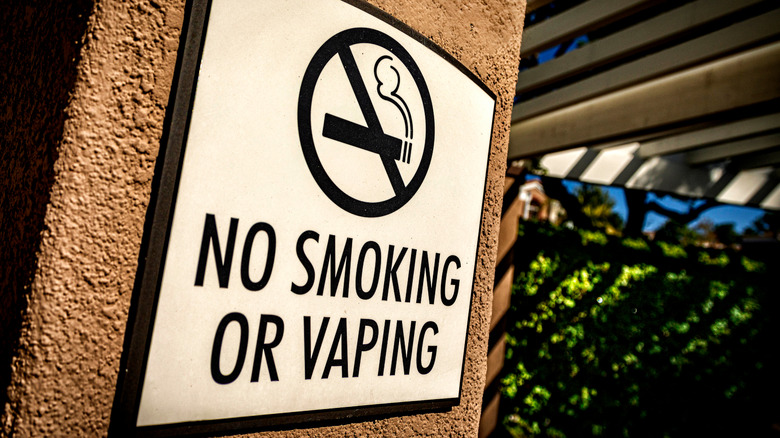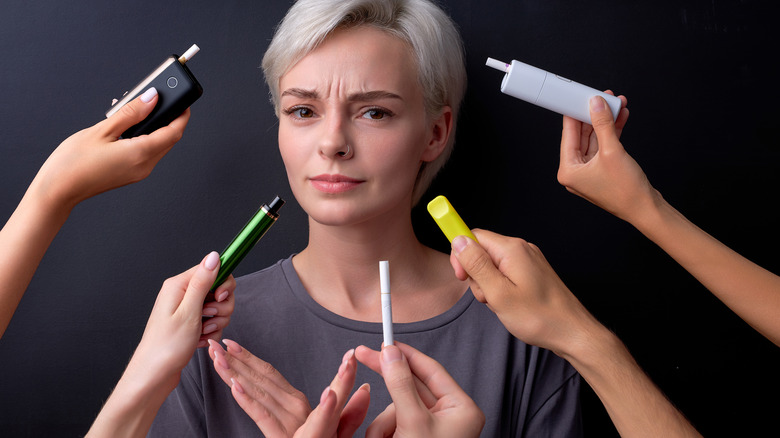How Vaping Prevention Ads Help Curb Teen Smoking, According To The Author Of A New Study
According to data from the U.S. Food and Drug Administration (FDA) and U.S. Centers for Disease Control and Prevention (CDC) 2022 National Youth Tobacco Survey (NYTS), roughly one in every 10 kids in middle school or high school across the country have used e-cigarettes within the last 30 days.
In an interview with Health Digest, Dr. Seth Noar, Professor at the UNC Hussman School of Journalism and Media, discusses the findings of a new study published in JAMA Network Open, in which researchers looked at the effectiveness of vaping prevention ads in minimizing teens' susceptibility to vaping. "Use of e-cigarettes and vaping among adolescents continues to be an important public health issue, and levels of vaping appear to be increasing now that we are coming out of the pandemic," Dr. Noar explains, emphasizing the need for increased research around the subject. "We still have limited science on what types of vaping prevention strategies are effective, and more studies on this are urgently needed."
The design behind vaping prevention ads
Dr. Noar and the research team showed vaping prevention ads to more than 1,500 teen participants between the ages of 13 and 17 in the U.S. who were either current users of e-cigarettes or were susceptible to vaping, as per the study. Participants were shown either a neutral video about vaping, or vaping prevention ads focused on related health harms or themes of addiction. "These advertisements were among several that the FDA has produced as part of its national The Real Cost vaping prevention media campaign," Dr. Noar tells Health Digest. "The health harms ads focus on harmful chemicals and metals that those who vape are likely inhaling, and the possible lung damage that can result from vaping. The addiction ads focus on how highly addictive nicotine is, and how nicotine addiction can negatively affect your mood and relationships with others." Such advertisements used in the study included Epidemic, Vaping Mistake, and Nicotine Addiction Isn't Pretty, amongst others.
Research findings showed that after three weeks, teens who had watched the Real Cost ads were less susceptible to vaping compared to adolescents who had watched a neutral vaping video. Even more, researchers saw the effects of the study also extend beyond just e-cigarette use.
The effects of vaping prevention ads on teen cigarette use
In addition to decreases in vaping susceptibility, the study also showed that teens exposed to the Real Cost ads were less susceptible to smoking cigarettes as well. "This is now the second study where we have found what we call positive spillover effects of tobacco prevention ads," Dr. Noar explains. "Vaping has many similarities to smoking — the look of the product, the hand-to-mouth motion when someone is vaping or smoking, the addictive nature of nicotine, and the negative effects of smoke or aerosol on the lungs."
Offering a possible explanation for this outcome, Dr. Noar adds, "It may be that as adolescents better understand that vaping is not risk-free — that it in fact has harms associated with it — that it reinforces the already negative view that most adolescents have about smoking cigarettes." As reflected in the study, teens in the Real Cost ads groups were also reported to have less positive attitudes towards vaping and smoking by the end of the study than teens in the control group.
What makes an effective vaping prevention ad?
Although the study points to prevention ads as an effective means to curb teen smoking behaviors, Dr. Noar notes that just because one may work doesn't mean they all will. He elaborates, saying that there are many factors that influence the effectiveness of vaping prevention ads. "The impact of an ad is a function of many things, including its content or theme, look and feel, production value and style, and source, as well as the amount of exposure adolescents have to it," Dr. Noar states.
Even so, Dr. Noar emphasizes the significance of their study findings, stating, "This study is one of the very first studies to show — in a randomized clinical trial — that communicating about the addiction and health harms of vaping to adolescents can have a measurable impact on discouraging vaping — and smoking too." He concludes by declaring, "All in all, this study gives us a lot of confidence that understanding the consequences of addiction and the real health harms that can result from vaping are important messages that adolescents need to hear."
Learn more about Dr. Noar and the Communicating for Health Impact (CHI) Lab by visiting their website. You can read a similar study from their lab that was published in the journal Nicotine and Tobacco Research. Visit The Real Cost on YouTube.
If you or anyone you know needs help with addiction issues, help is available. Visit the Substance Abuse and Mental Health Services Administration website or contact SAMHSA's National Helpline at 1-800-662-HELP (4357).




